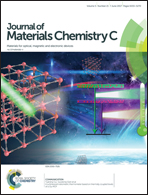Multifunctional sustainable materials: the role of carbon existing protein in the enhanced gas and UV sensing performances of ZnO-based biofilms†
Abstract
Due to environmental problems such as global warming and ozone depletion, it is essential to detect harmful UV rays from sunlight and to commercialize a clean energy source (H2), and both issues require a reliable sensor. With these considerations, herein, multifunctional ZnO-based biofilms with innovative designs (needle-fibre and jute-fibre like) are prepared by a simple hydrothermal route with sericin protein (SP) for different growing times, and fabricated as sensors. The present combination of ZnO/SP forms carbon and nitrogen enriched ZnO-based biofilms, which exhibit superior H2 and UV sensing characteristics. Among them, a sample grown for 5 h (with a jute-fibre like architecture) shows excellent H2 sensing and remarkable UV detection performance. Thus, the novel architecture based H2 sensor exhibits an ultra-fast response of 31.24% at 100 ppm within 11 s to reach a stable-state and easily recovers within 7 s, while the UV sensor shows an ultra-high photo-responsivity of 650 A W−1 with a response time of 16 s and a recovery time of 12 s, especially at room temperature. In particular, the as-fabricated sensor also produces good sensitivity/responsivity, high reversibility and long-term stability. This striking enhancement in sensing performance is attributed to the adsorptive coating of SP among ZnO lattice planes, which also affects the adsorption of chemisorbed ions from the surface of biofilms when exposed to H2 and UV atmosphere. Moreover, the present ZnO–SP based sensor overcomes the current problems of state-of-the-art room temperature ZnO based H2 and UV sensors with a cost-effective, eco-friendly and simple synthesis with easy fabrication. Furthermore, the salient feature of tailoring this bio-waste SP into versatile ZnO is the development of a low cost semiconductor nanocomposite biomaterial for multi-functional applications.



 Please wait while we load your content...
Please wait while we load your content...